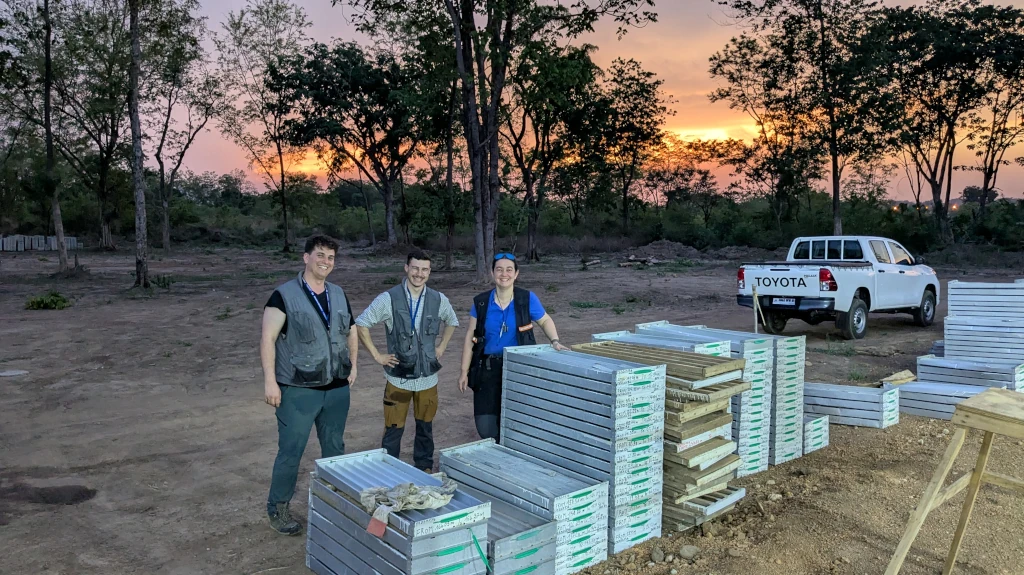
Award for best Poster and best presentation at the conference SGA 2025 -Lucas Danjon–Guillou answers a few questions
In the month of August, several members of the laboratory participated in the SGA 2025 conference in Golden, Colorado, USA.
Lucas Danjon–Guillou, a doctoral student within the GEM Team, and Célestine Berthier, who defended her thesis in February 2025, won the award for the best poster and the best presentation.

Left: Bastien AUDRAN; center: Lucas–DANJOU-GUILLOU; right: Anne-Sylvie ANDRÉ-MAYER.
Lucas answered a few questions about his experience at the SGA 2025 conference
Q1: You and Célestine Berthier won the award for best poster and best oral presentation at the SGA 2025 conference. First of all, what is SGA 2025, where does it take place, and who can participate to this event?
The SGA (Society for Geology Applied to Mineral Deposits) is an international scientific association that brings together researchers, professionals, and students working on topics related to the geology of mineral resources. Every two years, the SGA organizes a conference where stakeholders from around the world can meet to discuss and present their recent discoveries or research related to mineral exploration, resource exploitation, or the environment.
This year, to mark the organization’s 60th anniversary, the SGA 2025 conference was held at the Colorado School of Mines in Golden, USA, in early August, bringing together nearly 600 participants from more than 40 different countries.
SGA website: https://www.e-sga.org/events/biennial-meetings.
Q2: What was your poster and presentation for the SGA 2025 conference about?
My poster focused on research related to my thesis at the GeoRessources laboratory (Université de Lorraine-CNRS) in partnership with the WAXI (West African eXploration Initiative) project and within the dynamic of Labcom THEIA, a joint laboratory with Arethuse Geology. The overall objective of these projects is to link the formation of geological resources and the evolution of our planet Earth in the Precambrian era.
The specific objective of my doctoral work focuses on a gold-bearing district located at the interface between Archean and Proterozoic terrains, which has atypical characteristics in West Africa.
The poster for the SGA 2025 conference focused on the results obtained on a mining exploration target (Charger prospect in the Odienné region of Côte d’Ivoire).
Q3 – How did you prepare your presentation?
This work is the result of collaboration between many different parties, including the mining companies Awalé Resources and Newmont, which are exploring the area under study, as well as the entire academic research ecosystem conducting scientific work there.
Preparing a poster therefore involves, above all, exchanges and discussions to present the results obtained by each party and fuel scientific reflection.
Specifically, an extended summary was written and reviewed by all project collaborators and then by the SGA before being accepted. The poster was then created to present the results in a clear and easy-to-follow visual format, posing any questions that remained unanswered.
Q4: Is the research you presented with Célestine part of the WAXI (West African Exploration Initiative – phase 4) research project?
My thesis topic was initiated as part of the WAXI project, which has been running in West Africa since 2006, led by the Centre for Exploration Targeting at the University of Western Australia (Perth, Australia).
At the same time, GeoRessources has been collaborating with Arethuse Geology for 10 years, leading to the creation of a joint laboratory (LabCom ANR THEIA) in 2024.
Célestine’s work stems from a CIFRE thesis carried out with Arethuse Geology, but deployed outside the WAXI project, in the Tanzanian craton, allowing for discussion of gold metallogenic systems.
Q5: What did you get out of the SGA 2025 conference, and what were the benefits of presenting the poster?
We got a lot out of this conference. Just creating the poster itself was a great way to take a close look at the progress of our research and put our knowledge into words, which is a really good way to summarize things.
It also allowed us to ask questions that we don’t yet have the answers to, and the best part was being able to talk to scientists who are highly skilled in their fields and who can offer key advice or different approaches to try to answer those questions.
Finally, it allowed me to increase my scientific knowledge, keep up to date with the latest news in the field, and expand my professional network.
